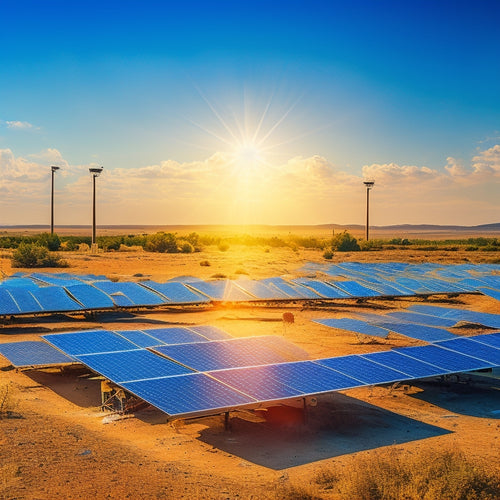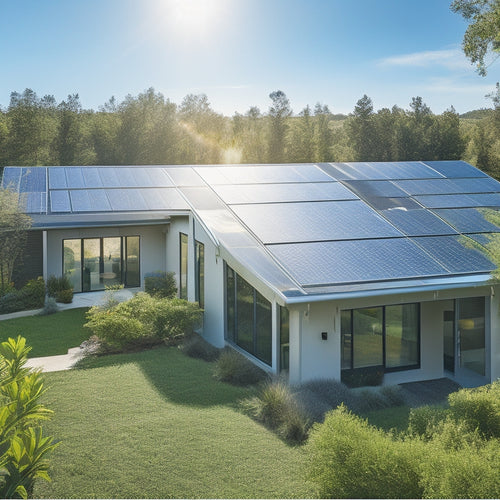
Diy Solar Generator Kit
Share
You're building a DIY solar generator kit to break free from reliance on the grid and tap into renewable energy, cutting your electricity bills and carbon footprint in the process. You'll need to select the right battery type, considering factors like charging cycles, maintenance, and lifespan, with lithium-ion and lead acid batteries being popular options. Properly sizing your battery capacity is vital, determined by your power needs and desired duration. You'll also need to calculate your daily energy requirements, considering appliance power ratings and total watt-hours. As you design your system, you'll want to investigate frame material options, like aluminum, stainless steel, and fiberglass, to guarantee durability and portability. Now, investigate the specifics to tailor your kit to your unique needs.
The Essentials
- DIY solar generator kits enable homeowners to generate their own electricity, reducing reliance on utility companies and saving on energy costs.
- When selecting a DIY kit, consider the battery type, capacity, and compatibility with solar panels to ensure efficient energy storage and output.
- Calculate daily energy requirements by totaling the power consumption of appliances, and oversize the battery capacity by 1.5 to 2 times to ensure reliable energy supply.
- Choose a frame material that balances weight, durability, and portability, such as aluminum alloys 6061-T6 or 6063-T5, for a functional and efficient DIY solar generator kit.
- Properly sizing the solar generator kit and selecting the right components can lead to significant cost savings and a reduced carbon footprint.
Renewable Energy Independence Now
You're now on the cusp of achieving energy freedom, where you can generate your own power and reduce your reliance on the grid.
By utilizing natural power sources like solar energy, you can enjoy independence from fossil fuels and their volatile prices.
With a DIY solar generator kit, you can tap into this clean energy and start producing your own electricity.
Energy Freedom Now Possible
The advent of renewable energy technologies has brought humanity to the cusp of an era where energy freedom is finally within reach. You're no longer bound by the constraints of traditional energy sources, and the possibility of off-grid living is now a tangible reality.
With solar technology advancements, you can capture the power of the sun to generate electricity, reducing your reliance on the grid and giving you the freedom to live life on your own terms. In fact, integrated solar solutions like All in One Solar Power Systems streamlined energy solutions are making it easier than ever to shift to renewable energy.
As you consider taking the leap towards energy independence, you'll want to assess your energy needs and determine the best approach for your specific situation. This might involve evaluating your current energy consumption, identifying areas for reduction, and selecting the right solar generator kit for your needs. By doing so, you'll be able to design a system that meets your requirements, providing you with a reliable and sustainable source of energy.
With energy freedom within your grasp, you can rest assured that you're taking a significant step towards a more sustainable future. You'll be reducing your carbon footprint, saving money on energy costs, and enjoying the peace of mind that comes with being self-sufficient.
Harness Natural Power Sources
By leveraging natural power sources, such as solar, wind, and hydro energy, you can break free from the grid's constraints and tap into a reliable, sustainable flow of electricity. This shift towards renewable energy independence allows you to utilize the power of nature, reducing your reliance on fossil fuels and minimizing your carbon footprint.
| Natural Power Source | Advantages | Challenges |
|---|---|---|
| Solar Energy | High solar panel efficiency, abundant resource | Intermittent energy supply, land requirements |
| Wind Energy | Low operating costs, scalable | Noise pollution, visual impact |
| Hydro Energy | High energy conversion rate, reliable | Dependent on water resources, infrastructure costs |
Zero Energy Bills Guaranteed
You're now on the path to achieving zero energy bills, and the financial benefits are substantial.
By utilizing solar power with your DIY generator kit, you'll cut energy costs now and save money monthly - a significant reduction in your expenses.
With a well-designed system, you can expect to offset your electricity consumption, leading to a drastic decrease in your utility bills.
Cut Energy Costs Now
As energy prices continue to skyrocket, cutting energy costs has become a top priority for many homeowners. You're likely no exception, seeking ways to reduce your reliance on the grid and lower your energy bills.
By incorporating energy-efficient solutions into your daily life, you can make a significant impact on your wallet and the environment. With a DIY solar panel kit, you can overcome common barriers such as high electricity bills and limited grid connection in remote areas, allowing you to generate clean energy and reduce your utility bills.
Investing in a DIY solar generator kit is a great starting point. This sustainable living approach allows you to utilize the power of the sun, reducing your energy consumption and carbon footprint.
Save Money Monthly
Your monthly energy bills are about to take a drastic turn for the better. With your DIY solar generator kit, you'll be utilizing the power of the sun to generate electricity, greatly reducing your reliance on the grid. This means you'll be saving money month after month, with the potential to eliminate your energy bills entirely.
By investing in budget-friendly alternatives like solar panels and energy efficient upgrades, you'll be cutting down on your energy consumption and costs. These upgrades will optimize your energy usage, ensuring that you're using only what you need.
Additionally, with DIY solar kits, you can overcome common challenges such as high installation costs and complexity in determining the right equipment for your specific needs. Plus, with solar power, you'll be generating clean energy, reducing your carbon footprint and contributing to a sustainable future.
As you continue to save money on your energy bills, you'll have more freedom to allocate your funds towards other important aspects of your life. Imagine the peace of mind that comes with knowing you're in control of your energy costs, and that you're doing your part for the environment.
With your DIY solar generator kit, you're taking a major step towards energy independence and a more financially secure future.
Deep Cycle Battery Inclusion
You'll need to evaluate the type of deep cycle battery that best suits your DIY solar generator kit, as different chemistries (flooded, AGM, or lithium-ion) offer varying performance, maintenance, and cost characteristics.
For instance, lithium-ion batteries are known for their high-performance and long lifespan, making them a popular choice for home solar panel battery systems.
When selecting a battery, you'll also need to choose a capacity that aligns with your energy storage needs, which will depend on factors like your daily energy usage and desired backup time.
Battery Type Considerations
Selecting the right battery type is crucial for a DIY solar generator kit, as it directly impacts the system's overall performance and lifespan. You need to take into account factors like battery lifespan, charging cycles, and maintenance requirements to guarantee your system runs efficiently. Two popular battery types for DIY solar generator kits are lead acid and lithium.
| Battery Type | Advantages | Disadvantages |
|---|---|---|
| Lead Acid | Lower upfront cost | Limited charging cycles (200-300) |
| Lead Acid | Well-established technology | Heavier and bulkier |
| Lithium | Higher energy density | Higher upfront cost |
| Lithium | Longer lifespan (3000-5000 cycles) | Requires specialized charging system |
| Lithium | Faster discharge rates | Environmental concerns in disposal |
When choosing a battery type, weigh lithium advantages like higher energy density and longer lifespan. However, lead acid limitations like limited charging cycles and bulkier design should also be factored in. Temperature effects, environmental impact, cost considerations, and compatibility factors must also be evaluated to confirm your DIY solar generator kit meets your needs and provides the freedom you desire.
Battery Capacity Options
Two key factors determine the battery capacity of your DIY solar generator kit: the amount of power you need and the duration you want it to last.
You'll want to calculate your total watt-hours (Wh) to verify your battery can handle the load. A general rule of thumb is to oversize your battery capacity by 1.5 to 2 times your total Wh requirement.
When selecting a deep cycle battery, consider the ampere-hour (Ah) rating and voltage. A higher Ah rating means more energy storage, while a higher voltage means more power.
You'll need to balance these factors to achieve peak performance. For example, a 12V 200Ah battery provides more energy storage than a 12V 100Ah battery, but the latter might be more suitable for smaller systems.
To promote battery longevity, avoid deep discharging (below 50% state of charge) and keep your battery within the recommended temperature range.
Proper maintenance and monitoring will help you get the most out of your battery. By choosing the right battery capacity for your DIY solar generator kit, you'll enjoy reliable power and extended battery life, giving you the freedom to live off the grid.
Calculate Your Power Needs
You'll need to determine your daily energy requirements to size your solar generator kit correctly. This involves calculating the total watt-hours (Wh) per day required to power your appliances, which can be done by checking their power ratings.
When designing your off-grid solar power system, it's essential to take into account renewable energy solutions and the backup power needs during outages. For example, if you plan to power a 20W laptop for 5 hours and a 10W LED light for 10 hours, you'll need a total of 150Wh per day.
Daily Energy Requirements
Determining your daily energy requirements is an important step in building a DIY solar generator kit that meets your specific power needs.
You'll need to calculate how much energy you consume daily to guarantee your solar generator kit can provide sufficient power. To do this, you'll need to identify the devices you want to power and their respective energy consumption rates.
Start by making a list of all the devices you want to power with your solar generator kit, including lights, laptops, refrigerators, and other vital appliances.
Next, estimate how many hours you'll use each device daily. Then, calculate the total daily energy consumption by multiplying the device's power rating (in watts) by the number of hours used.
Effective power management is essential to guaranteeing your solar generator kit can meet your daily energy requirements.
You'll need to take into account factors like peak sun hours, battery capacity, and inverter efficiency to make sure you're generating enough power to meet your needs.
Appliance Power Ratings
Appliance Power Ratings (Calculate Your Power Needs)
The power rating of each appliance is a critical factor in calculating your daily energy requirements. You need to determine the appliance wattage to accurately assess your power consumption. This information is usually found on the appliance's nameplate or in the user manual.
Make a list of all the appliances you plan to power with your DIY solar generator kit, including their respective wattages.
Next, calculate the total power consumption by adding up the wattages of all the appliances. This will give you your total daily energy requirement in watt-hours (Wh). For example, if you have a laptop that consumes 65W, a fan that consumes 50W, and a light bulb that consumes 10W, your total power consumption would be 125W.
To convert this to watt-hours, you need to know how many hours each appliance will be used per day. Let's say you plan to use the laptop for 8 hours, the fan for 6 hours, and the light bulb for 4 hours.
Your total daily energy requirement would be 1040Wh (65W x 8h + 50W x 6h + 10W x 4h). This calculation will help you determine the size of your solar generator kit and the number of solar panels you'll need to generate enough power.
Lightweight Aluminum Frame Design
You'll consider two primary frame material options for your DIY solar generator kit: aluminum and steel.
Aluminum is a popular choice due to its high strength-to-weight ratio, corrosion resistance, and lower cost compared to steel.
When selecting an aluminum frame, you'll need to choose from various alloys, such as 6061-T6 or 6063-T5, each with its own unique properties and trade-offs.
Frame Material Options
Selecting the right frame material for your DIY solar generator kit is crucial, as it directly affects the overall weight, durability, and portability of your system. You'll want a material that's both strong and lightweight, guaranteeing your generator is easy to transport and can withstand harsh outdoor conditions.
When it comes to frame material options, you have a few choices. Aluminum is a popular choice for DIY solar generator kits due to its high strength-to-weight ratio, corrosion resistance, and affordability. A lightweight aluminum frame design can notably reduce the overall weight of your system, making it easier to move around.
Additionally, aluminum frames are often anodized or powder-coated, which enhances their frame durability and aesthetics.
Other options include stainless steel, which offers excellent corrosion resistance, and fiberglass, which is lightweight and durable. However, these materials may be more expensive than aluminum.
Ultimately, the frame material you choose will depend on your specific needs and preferences. Consider factors like weight, durability, and cost when making your decision, and confirm your frame material aligns with your DIY solar generator kit's overall design and functionality.
Frequently Asked Questions
Can I Customize the DIY Solar Generator Kit to Fit My Specific Needs?
You can tailor a DIY solar generator kit to meet your custom power requirements by making specific component choices, such as selecting the right inverter, battery, and solar panels to guarantee your system efficiently generates power for your unique needs.
How Long Does It Take to Assemble the Solar Generator Kit?
When you tackle a DIY project, you'll want to know the assembly time beforehand. Depending on the kit complexity, it'll take you around 2-5 hours to assemble, assuming you're moderately handy and follow the instructions carefully.
Is the DIY Solar Generator Kit Suitable for Outdoor Use?
When you're off-grid, 71% of explorers prioritize reliable power; you'll want a system that's up for the task. Your outdoor setup demands high power efficiency and flexible portability options, ensuring you stay connected and free wherever you roam.
Can I Use the Solar Generator Kit for Emergency Power Backup?
When power outages strike, you'll be prepared with a reliable emergency backup, achieving energy independence by utilizing renewable energy; with the right setup, you can guarantee your essential appliances stay powered, keeping you safe and self-sufficient.
Is the DIY Solar Generator Kit Compatible With Existing Solar Panels?
Ha! You think you can just slap any old solar panels onto your generator kit and call it a day? Think again! You'll need to guarantee compatibility, checking installation requirements like voltage, wattage, and connector types to avoid a DIY disaster.
Final Thoughts
As you utilize the power of the sun, your DIY solar generator kit converts into a signal of energy independence, illuminating your path to zero energy bills. With a deep cycle battery at its core, this kit is your key to accessing a sustainable future. Calculate your power needs, and let the lightweight aluminum frame design do the rest. Now, take the first step towards a brighter tomorrow, where the only bill you'll receive is a thank-you note from Mother Nature.
Related Posts
-

What Happens Without a Charge Controller in Solar Panels
Without a charge controller in your solar panel system, you risk overheating batteries due to overcharging, which can...
-

Top 10 Off Grid Camping Gear Must-Haves
When you're off-grid camping, the right gear is crucial for a smooth expedition. Start with a durable, weather-resist...
-

Installing Metal Solar Roofs for Maximum Energy Efficiency
Installing metal solar roofs can drastically enhance your home's energy efficiency and durability. These roofs withst...


